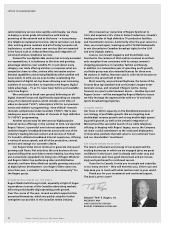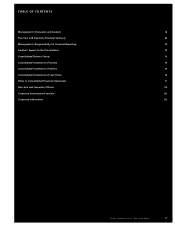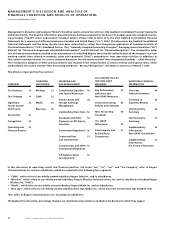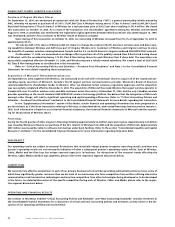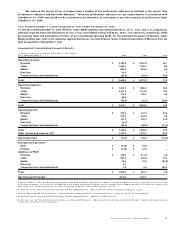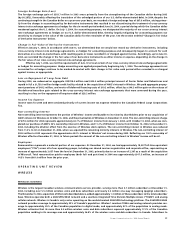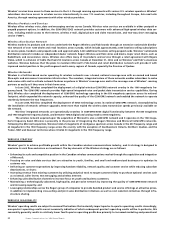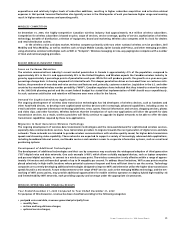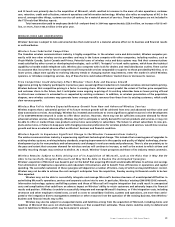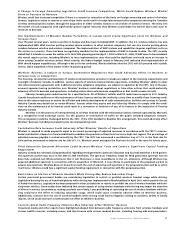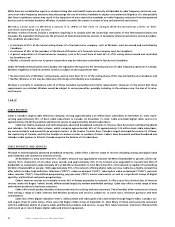Rogers 2004 Annual Report Download - page 25
Download and view the complete annual report
Please find page 25 of the 2004 Rogers annual report below. You can navigate through the pages in the report by either clicking on the pages listed below, or by using the keyword search tool below to find specific information within the annual report.
23
Rogers Communications Inc. 2004 Annual Report
Foreign Exchange Gain (Loss)
The foreign exchange gain of $303.7 million in 2003 arose primarily from the strengthening of the Canadian dollar during 2003
(by $0.2872), favourably affecting the translation of the unhedged portion of our U.S. dollar-denominated debt. In 2004, despite the
continuing strength in the Canadian dollar on a year-over-year basis, we recorded a foreign exchange loss of $67.6 million, arising primar-
ily from the change in accounting policy for derivative instruments that resulted in our discontinuing the treatment of cross-currency
interest rate exchange agreements as hedges for the six-month period ended June 30, 2004, a period during which the Canadian dollar
weakened against the U.S. dollar. On July 1, 2004, for accounting purposes, we designated the majority of our cross-currency interest
rate exchange agreements as hedges on our U.S. dollar-denominated debt, thereby largely mitigating for accounting purposes our
sensitivity to changes in the value of the Canadian dollar for the remainder of the year. See the section entitled “Change in Fair Value
of Derivative Instruments” below.
Change in Fair Value of Derivative Instruments
Effective January 1, 2004, in accordance with AcG-13, we determined that we would not record our derivative instruments, including
cross-currency interest rate exchange agreements, as hedges for accounting purposes and consequently began to account for such
derivatives on a mark-to-market basis, with resulting gains or losses recorded in or charged against income. Accordingly, up to June 30,
2004, we recorded the change in the fair value of our derivative instruments as either income or expense, depending on the change in
the fair value of our cross-currency interest rate exchange agreements.
Effective July 1, 2004, we met the requirements of AcG-13 to treat certain of our cross-currency interest rate exchange agreements
as hedges for accounting purposes. Hedge accounting was applied prospectively beginning July 1, 2004. The exchange agreements not
accounted for as hedges continue to be marked-to-market with their change in fair value each period either recorded in or charged
against income, as appropriate.
Loss on Repayment of Long-Term Debt
During 2004, we redeemed an aggregate US$708.4 million and $300.0 million principal amount of Senior Notes and Debentures and
repaid in full a $1,750.0 million bridge credit facility related to the acquisition of AWE’s interest in Wireless. We paid aggregate prepay-
ment premiums of $49.2 million, and wrote off deferred financing costs of $19.2 million, offset by a $40.2 million gain on the release of
the deferred transition gain related to the cross-currency interest rate exchange agreements that were unwound during the year,
resulting in a loss on the repayment of long-term debt of $28.2 million.
Income Tax Expense
Income taxes for 2004 and 2003 consisted primarily of current income tax expense related to the Canadian Federal Large Corporations
Tax.
Non-controlling Interest
Non-controlling interest represents the portion of Wireless’ income attributable to its minority shareholders prior to our acquisition of
AWE’s interest in Wireless on October 13, 2004, and the privatization of Wireless on December 31, 2004. The non-controlling interest charge
of $79.6 million for 2004 represents approximately 44.7% of Wireless’ income from January 1, 2004, until October 13, 2004, when we com-
pleted our purchase of AWE’s 34% ownership interest in Wireless, and 11.2% of Wireless’ income from October 13, 2004, to December 31,
2004, including the dilution effect from the exercise of Wireless stock options. The non-controlling interest in Wireless was reduced
from 11.2% to nil on December 31, 2004, when we acquired the remaining minority interests in Wireless. The non-controlling interest of
$58.4 million in 2003 represents the approximate 44.2% interest in Wireless’ net income during 2003. Reflecting our 100% ownership of
Wireless effective December 31, 2004, in future periods the amount of the non-controlling interest in Wireless’ income will be nil.
Employees
Remuneration represents a material portion of our expenses. At December 31, 2004, we had approximately 18,057 full-time equivalent
employees (“FTEs”) across all of our operating groups, including our shared services organization and corporate office, representing an
increase of approximately 3,057 from the level at December 31, 2003, primarily due to an increase of 2,397 as a result of the acquisition
of Microcell. Total remuneration paid to employees (both full- and part-time) in 2004 was approximately $917.5 million, an increase of
14.5% from $801.0 million from the prior year.
OPERATING UNIT REVIEW
WIRELESS
WIRELESS BUSINESS
Wireless is the largest Canadian wireless communications service provider, serving more than 5.7 million subscribers at December 31,
2004, including over 5.5 million wireless voice and data subscribers and nearly 0.2 million one-way messaging (paging) subscribers.
The November 9, 2004, acquisition of Microcell, described above, added approximately 1.3 million of these subscribers to the total subscriber
base. Wireless operates both a GSM/GPRS/EDGE network and a seamless integrated Time Division Multiple Access (“TDMA”) and analog
cellular network. Wireless is Canada’s only carrier operating on the world standard GSM/GPRS technology platform. The GSM/GPRS/EDGE
network provides coverage to approximately 93% of Canada’s population. Wireless’ seamless TDMA and analog network provides cov-
erage to approximately 85% of the Canadian population in digital mode, and approximately 93% of the population in analog mode.
Wireless estimates that its more than 5.5 million wireless voice and data subscribers represent approximately 17.3% of the Canadian
population residing in its coverage area and approximately 36.8% of the wireless voice and data subscribers in Canada. Subscribers to





